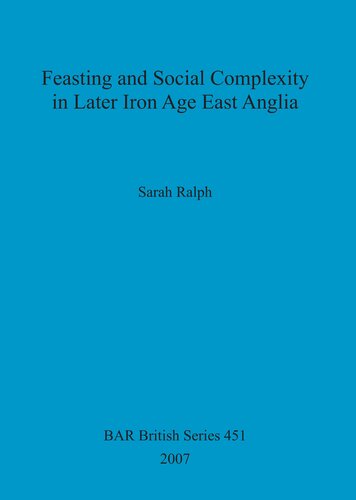

Most ebook files are in PDF format, so you can easily read them using various software such as Foxit Reader or directly on the Google Chrome browser.
Some ebook files are released by publishers in other formats such as .awz, .mobi, .epub, .fb2, etc. You may need to install specific software to read these formats on mobile/PC, such as Calibre.
Please read the tutorial at this link: https://ebookbell.com/faq
We offer FREE conversion to the popular formats you request; however, this may take some time. Therefore, right after payment, please email us, and we will try to provide the service as quickly as possible.
For some exceptional file formats or broken links (if any), please refrain from opening any disputes. Instead, email us first, and we will try to assist within a maximum of 6 hours.
EbookBell Team

5.0
90 reviewsThis study looks at the changes that were taking place within later Iron Age society in East Anglia (the counties of Cambridgeshire, Hertfordshire, Essex, Norfolk and Suffolk, England) and the rise of complexity on both a macro and micro scale. To do this the author focuses on feasting and consumption and the role it played in changing the face of society during the Iron Age. It is not just food or drink themselves that are important, but also their consumption as a social event. The research focuses on a number of issues: Recognising the feast in the archaeological record; Separating the feast from daily cuisine and the relationship between them; and through her dataset, the author considers over time (and space): The structure and symbolism of the feast; The specific events that are marked by archaeologically visible feasts and whether this changes over time and space; How feasts were organised, which is in turn linked to; Agency – who is holding the feasts and for whom? Who is doing the consuming and who is acquiring the items for feasting? How many people attended these events – can this be distinguished in the archaeological record? How are feasts involved in lifecycles, both temporally and spatially? Consequently, this research enhances current knowledge of Iron Age society through an investigation of feasts and their social effects. By identifying known major social changes in Iron Age Britain, the author has been able to demonstrate how these events are reflected or articulated in feasting practices, and has highlighted new ways in which to identify feasts and the different modes of consumption through a reanalysis of old sites and the study of new ones. Additionally, this research has sought to fill some gaps in our knowledge of Iron Age Britainand brought research into East Anglia up to the same standard achieved in Wessex. As well as providing a new and important perspective to the study of Iron Age Britain, this work will aid the understanding of Iron Age society as a whole.